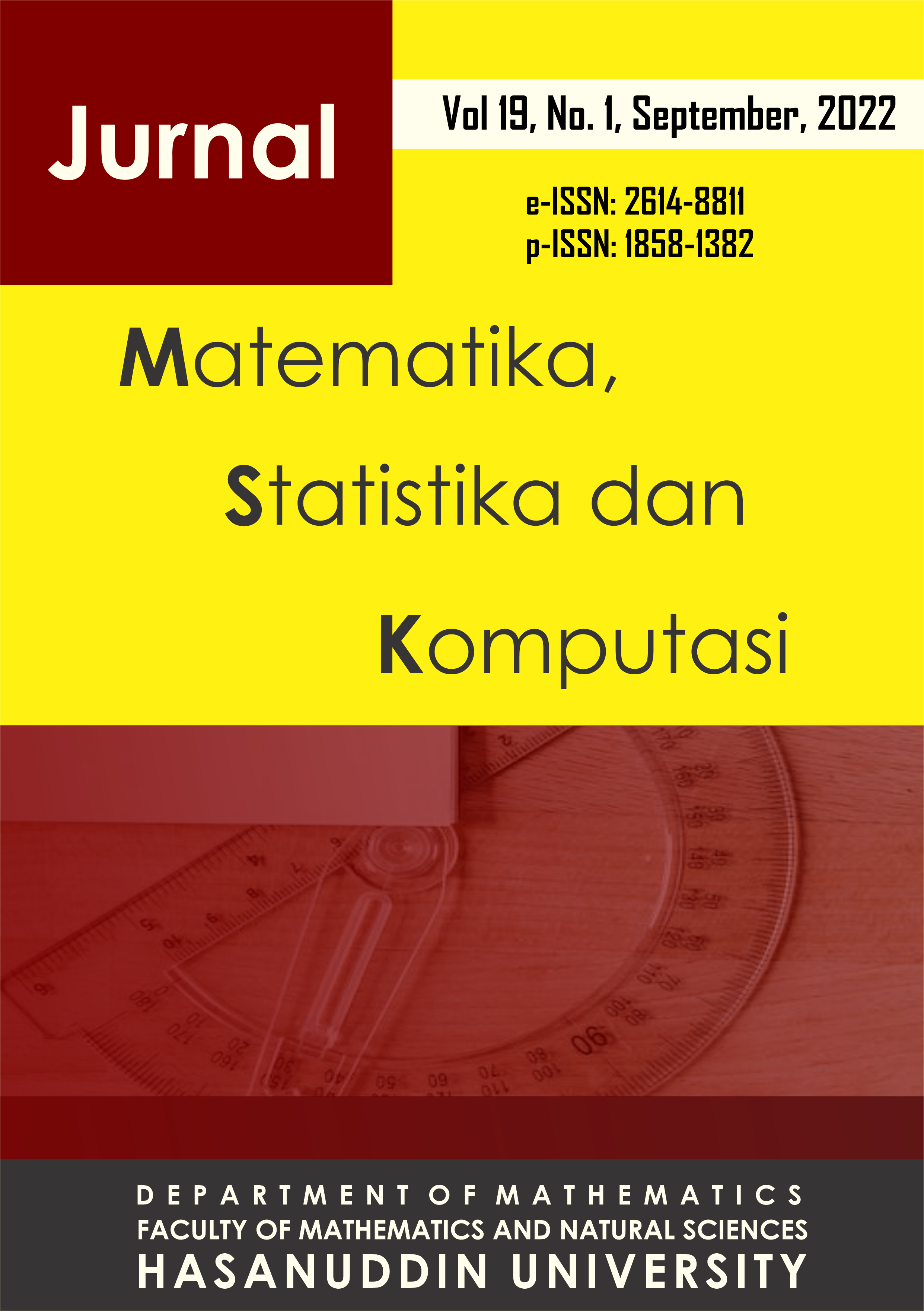The Application Of K – Harmonic Means Method In District/City Grouping
DOI:
https://doi.org/10.20956/j.v19i1.21116Keywords:
Poverty, K-Harmonic Means, Silhouette CoefficientAbstract
Poverty is one of the problems that faced by every country in the world, especially in developing countries, one of them is Indonesia. Poverty alleviation that is currently planned is no longer uniform, but it is necessary to pay attention to the condition of each dimension causing poverty in an area, so it is necessary to group districts/cities on the Kalimantan Island based on poverty. Cluster analysis is classifying the data (objects) only based on the information discovered in the data that describes the objects and the relations between them. The method used in this research is K-Harmonic Means method. K-Harmonic Means is a non-hierarchical clustering algorithm that uses the average harmonic distance from each data point to the cluster center. This study aims to classify the District/City in Kalimantan Island based on poverty indicators and obtain the silhouette coefficient value from the optimal cluster analysis. Based on the results of the analysis of the K-Harmonic Means method, the optimal number of clusters is 2 clusters with parameter (p) of 4. Cluster 1 consists of 11 Districts/Cities and Cluster 2 consists of 45 Districts/Cities. Silhouette coefficient value for data validation of District/City clustering results on Kalimantan Island using the K-Harmonic Means method, namely 2 clusters with parameter (p) of 4 is 0.323 which states that the resulting cluster structure in this grouping is a weak structure.
References
Agusta, I., 2007. Desa Tertinggal di Indonesia. Jurnal Transdisiplin Sosiologi, Komunikasi dan Ekologi Manusia. Vol 1, No 2, 233-252, ISSN:1978-4333.
Aziz, Nyimas Latifah, L., 2019. Relokasi Ibu Kota Negara: Lesson Learned Dari Negara Lain. Jurnal Kajian Wilayah 10 (2019) 37-64.
Bappenas, 2018. Analisis Wilayah Dengan Kemiskinan Tinggi. Jakarta: Kedeputian Bidang Kependudukan dan Ketenagakerjaan Kementrian PPN/Bappenas.
Gungor, Z dan Unler, A., 2007. K-Harmonic Means Data Clustering with Simulated Annealing Heuristic. Applied Mathematics and Computation, Vol. I84, 199-209.
Jollyta, Deny., Siddik, Muhammad., Mawengkang, Herman., & Efendi, Syahril, 2021. Teknik Evaluasi Cluster Solusi Menggunakan Python dan RapidMiner. Yogyakarta: DEEPUBLISH.
Handoyo, Rendy., M Rumani, R., & Nasution, Surya Michrandi, 2014. Perbandingan Metode Clustering Menggunakan Metode Single Linkage dan K-Means Pada Pengelompokan Dokumen. JSM STMIK Mikroskil ISSN.1412-0100 Vol 15, No 2 Hal. 73-82.
Kaufman, L., & Rousseeuw, P. J., 1990. Finding Groups in Data. New York: John Wiley & Sons.
Marthalina, 2018. Peran Pemerintah Daerah Dalam Mengentaskan Kemiskinan di Kabupaten Tangerang Provinsi Banten. TRANSFORMASI: JURNAL MANAJEMEN PEMERINTAHANVOL. 10 NO.1 MARET 2018: 1-24.
Prasetyo, E., 2012. Data Mining: Konsep dan Aplikasi Menggunakan Matlab. Yogyakarta: Andi.
Putri, R. F., Sumantyo, J. T. S., Sukamdi, & Harini, R., 2019. Human And Economic Resource Mapping Analysis to Evaluate the SDGs Accomplishment in South Kalimantan, Indonesia. Jurnal Geografi Indonesia, 51, 364–384.
Rahmatulloh, 2017. DINAMIKA KEPENDUDUKAN DI IBUKOTA JAKARTA (Deskripsi Perkembangan Kuantitas, Kualitas dan Kesejahteraan Penduduk di DKI Jakarta). GENTA MULIA Volume VIII No. 2, Juli 2017 Page: 54-67.
Saptadi, N. T. S., Chyan, P., & Taga, V. P., 2021. Using K-Means Algorithm to Investigate Community Behavior in Treating Waste toward Smart City. International Journal on Advanced Science, Engineering and Information Technology, 11(4), 1455–1462.
Srivastava, P., & Mostafavi, A., 2018. Challenges and opportunities of crowdsourcing and participatory planning in developing infrastructure systems of smart cities. Infrastructures, 3(4).
Suryawati, Chriswardani, 2005. Memahami Kemiskinan Secara Multidimensional. JMPK Vol. 08/No. 03/ September/ 2005, Hal. 121-129.
Trisnu, Cokorda, G, S, P., & Sudiana, I Ketut, 2019. Pengaruh Pertumbuhan Penduduk, Pengangguran dan Pendidikan Terhadap Tingkat Kemiskinan Kabupaten/Kota Provinsi Bali. E-Jurnal Unud, 8 [11]: 2622 – 2655.
Widiartha, I. M., 2011. Studi Komparasi Metode Klasterisasi Data K-Means Dan K-Harmonic Means. Jurnal Ilmu Komputer, 30-34.
Zhang, B., Hsu, M., & Dayal, U.,1999. Clustering Algorithm K -Harmonic Means -A Data Clustering Algorithm. Hewlett-Packard Labs Technical Report HPL-1999-124.
Zhu, A., Hua, Z., Shi, Y., Tang, Y., & Miao, L.,2021. An improved k-means algorithm based on evidence distance. Entropy, 23(11).
Downloads
Published
How to Cite
Issue
Section
License
Copyright (c) 2022 Author and publisher

This work is licensed under a Creative Commons Attribution 4.0 International License.

This work is licensed under a Creative Commons Attribution 4.0 International License.
Jurnal Matematika, Statistika dan Komputasi is an Open Access journal, all articles are distributed under the terms of the Creative Commons Attribution License, allowing third parties to copy and redistribute the material in any medium or format, transform, and build upon the material, provided the original work is properly cited and states its license. This license allows authors and readers to use all articles, data sets, graphics and appendices in data mining applications, search engines, web sites, blogs and other platforms by providing appropriate reference.







